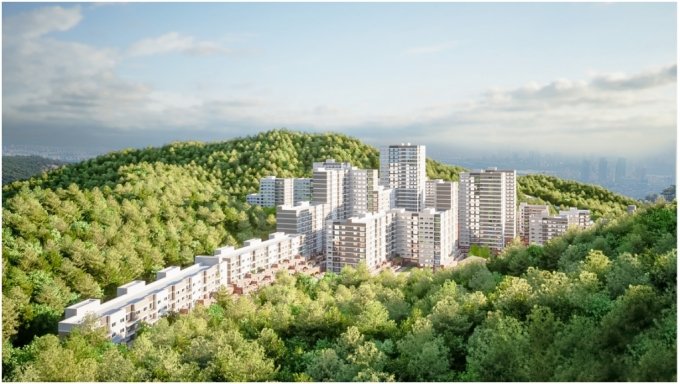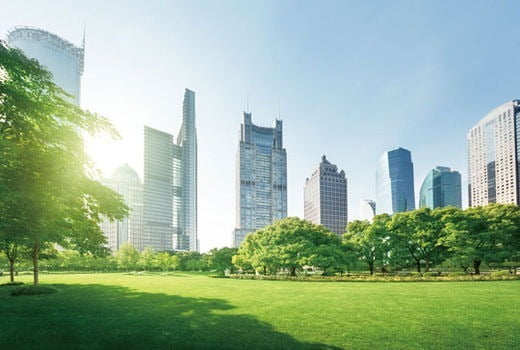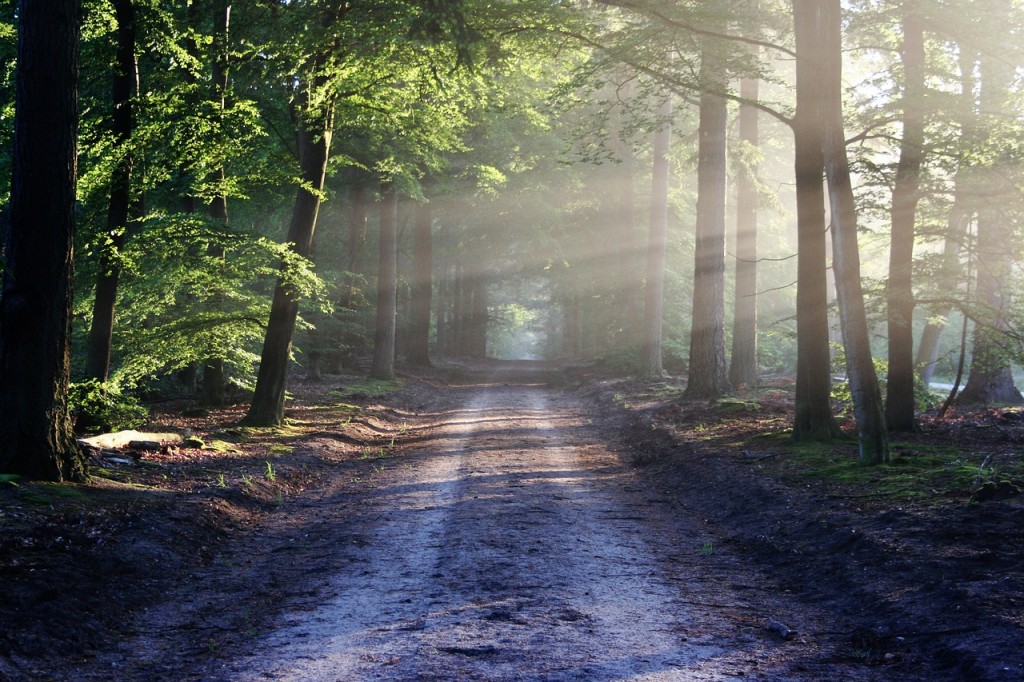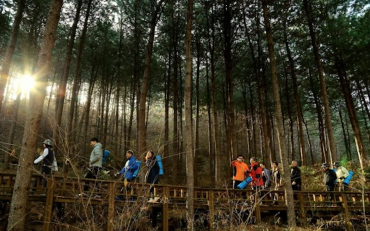
The preference for neighborhoods with large parks and green spaces has become more pronounced due to the phenomenon of telecommuting, which has been widely adopted during the coronavirus pandemic. (Image courtesy of National Institute of Forest Science)
SEOUL, July 9 (Korea Bizwire) — The criteria for Koreans choosing an apartment, the most common form of housing in the country, are undergoing a transformation. In the past, the proximity to subway stations, known as ‘Yeokssekwon’ or station areas, was considered an essential factor due to its emphasis on transportation convenience.
However, there is now a shift towards preferring areas such as ‘Gongsekwon’ (residential areas adjacent to green spaces such as parks) and ‘Supsekwon’ (residential areas adjacent to forests), which offer greenery and parks for residents to enjoy.
The preference for neighborhoods with large parks and green spaces has become more pronounced due to the phenomenon of telecommuting, which has been widely adopted during the coronavirus pandemic.
These areas are now more appealing than those near subway stations, as they have a significant impact on healthy lifestyle among prospective house buyers. Moreover, the rise in fine dust pollution has also contributed to the growing interest in living in environments with lower air pollution levels and a greater sense of comfort.
Yeokssekwon refers to areas adjacent to subway stations, which are also known as the station’s sphere of influence. A recent survey conducted by the Metavey platform, which involved 200 participants ranging from 10 to 60 years old, asked the question, “Where would you buy or sell an apartment at the same price?”
The results showed that 35.1 percent of respondents preferred places with green spaces like parks, making it the most popular choice. Yeokssekwon ranked second at 26.6 percent, followed by 17.6 percent for a well-equipped security system, 10.6 percent for great community facilities, and 10.1 percent for apartments in good school districts.

The preference for neighborhoods with large parks and green spaces has become more pronounced due to the phenomenon of telecommuting, which has been widely adopted during the coronavirus pandemic. (Image courtesy of the Seoul Metropolitan Government)
These findings indicate that an increasing number of urban residents are feeling fatigued by the concrete jungle of skyscrapers and are seeking access to forests and parks. The COVID-19 pandemic has further highlighted the importance of such spaces, leading to the construction of newer apartment buildings with on-site parks.
Apartments located near parks and forests also command higher prices compared to those without such amenities.
Interestingly, price is not the primary factor considered when choosing an apartment. The survey revealed that neighborhood infrastructure ranked first at 26.1 percent, followed by price at 21.8 percent.
Other factors included brand reputation at 20.7 percent, facilities inside the apartment or complex at 18.1 percent, and the overall neighborhood at 13.3 percent.
Regarding preferred living arrangements, over half of the respondents (52.9 percent) chose apartment complexes, while 21.2 percent preferred detached houses, 15.3 percent favored small apartments, and 10.6 percent opted for villas.

Apartments located near parks and forests also command higher prices compared to those without such amenities.
In recent years, the desire to return to a clean and natural environment has grown due to the increasing severity of air pollution, including extreme temperatures and fine dust.
The public’s interest in the healing power of forests has particularly surged, fueled by stories of terminal cancer patients finding solace and recovering in the forest after discontinuing treatment, which have gained popularity on platforms like YouTube.
Forests produce various beneficial chemicals, including phytoncides, which contribute to emotional stability and activate natural killer (NK) cells that inhibit or reduce the activity of malignant cells, such as cancer cells, thereby enhancing the body’s natural healing ability.
Oxygen, known as a powerful antidote, plays a crucial role in countering cancer by breaking down toxic substances like cortisol, which is released by the brain during times of extreme stress.
Oxygen also helps eliminate heavy metals harmful to the body, such as lead, mercury, and arsenic. Additionally, it directly influences happiness by facilitating the synthesis of serotonin, a neurotransmitter associated with calmness. Insufficient oxygen can lead to a decrease in serotonin synthesis, resulting in depression, insomnia, and anxiety.
If you suffer from chronic fatigue or lethargy, it is important to replenish your oxygen supply. The mitochondria in our cells require ample oxygen to break down nutrients and produce energy. Insufficient oxygen can lead to a significant drop in energy production, leaving you feeling tired.
Dr. Otto Warburg, a German biochemist and Nobel Prize laureate, proved that healthy cells deprived of oxygen can transform into cancer cells.

Oxygen, known as a powerful antidote, plays a crucial role in countering cancer by breaking down toxic substances like cortisol, which is released by the brain during times of extreme stress. (Image courtesy of Pixabay)
This finding suggests that oxygen deprivation is a significant factor in the development of cancer. Therefore, ensuring that the body receives sufficient oxygen is crucial for maintaining the health of normal cells.
Despite the growing recognition of the importance of green spaces, only 3.7 percent of Seoul’s total land area is available for public use as parks and green spaces.
Even when including palaces and other historical sites, the percentage rises to just 8.5 percent, which is considerably lower than other global metropolises like Manhattan, New York (26.8 percent), and Central London (14.6 percent).
In response to this issue, the Seoul Metropolitan Government announced plans to transform downtown Seoul into a “green ecological city” where buildings and trees coexist. The proposed measures involve relaxing existing building regulations, such as building height (90 meters or less) and floor area ratio (600 percent or less).
In exchange, the city aims to create parks and green spaces as public contributions, connecting the entire city center with greenery. By implementing this plan, Seoul hopes to increase its green space rate from the current 3.7 percent to over 15 percent.
While the total amount of green space in Seoul remains insufficient, the availability of green spaces within each borough significantly impacts residents’ satisfaction.

The preference for neighborhoods with large parks and green spaces has become more pronounced due to the phenomenon of telecommuting, which has been widely adopted during the coronavirus pandemic. (Image courtesy of Yonhap)
In a recent study on livable neighborhoods based on the Social Safety Index, Seocho-gu, a district in Seoul, ranked first in the city (and third in the country) due in part to its expansive 60 percent parkland. Seocho-gu is also renowned for housing the Yangjae Stream, which won the Asian Urban Landscape Award in 2016.
It is not an exaggeration to say that living closer to green spaces increases lifespan. In this vein, Seocho-gu takes the lead in terms of health and wellness nationwide, boasting a healthy life expectancy of 76.2 years and an overall life expectancy of 84.8 years.
According to a real estate market expert, the emphasis on residential comfort since the COVID-19 pandemic has led to the increasing popularity of ‘Supsekwon’ and ‘Gongsekwon’ complexes.
These complexes offer various advantages, including reducing fine dust, mitigating heat islands, relieving stress, and providing psychological stability. As a result, these residential options have gained significant attention not only in the housing subscription market but also in the housing sales market.
M. H. Lee (mhlee@koreabizwire.com)






